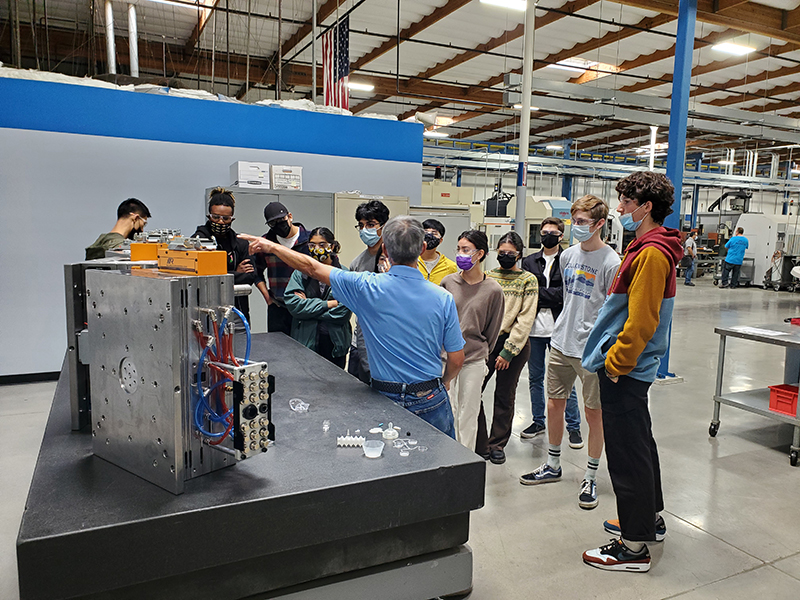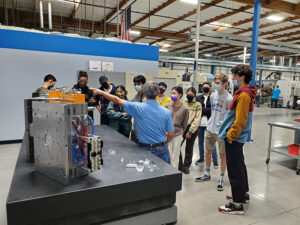
by Nicole Mitchell, editor, The American Mold Builder
One of the biggest struggles for any industry today is in attracting quality candidates for open job positions. When searching for employees, it’s critical to understand what individuals are looking for in a potential workplace and how job searchers find information. From salary and benefits to community involvement, today’s employment applicants want it all.
Set the stage with community involvement
Showing up and being involved in the community surrounding a mold building facility does more than inspire current employees; it helps get the word out about the company as well. Wepco Plastics is just one example of a manufacturing company that believes community involvement is beneficial.
“One of our four core values is impacting our community,” said Amanda Wiriya, manufacturing support director at Wepco, in the AMBA Workforce Playbook, which now is available to AMBA members at www.amba.org. The company has a strong history of partnering with local high schools and universities to promote careers, collaborate with nonprofits, participate in career fairs, bring students in for facility tours and more to engage in its community.
But connecting within a community doesn’t have to be restricted to school visits and plant tours. More creative ways manufacturers – especially those in remote areas – still can interact with their communities is by collaborating with other manufacturers or simply handing out referral cards. “Don’t forget that you are offering more than a job – you are offering them a career in manufacturing with many wonderful benefits,” Wiriya said.
The yearly Manufacturing Day (MFG Day) celebration gives those in the industry the perfect excuse to get involved in their communities. For MFG Day 2021, Wepco provided a variety of events for both its employees and the surrounding area – including facility tours, networking events and a competition for a $5,000 grant for educational institutions. “Manufacturing Day events address the manufacturing career myths heads-on,” Wiriya said. “That’s one of the biggest challenges to date.”
Some might argue that community activities aren’t necessary since they don’t always directly result in hiring. However, those at Wepco argue that it always is worth it. “Connections created and professional relationships maintained are where the true value lies,” Wiriya said. “Our name and reputation precede us because we make the effort to be consistently and passionately involved.” By connecting with its community, Wepco has helped spread local awareness that manufacturing careers can be creative, diverse and well-compensated, addressing one of the greatest misconceptions that those outside the
industry believe.

Choose the right channels to promote openings
Before sharing an open position just anywhere, mold builders should look into which channels have been successful for other companies in the industry. According to the AMBA Workforce Playbook, the top recruitment channel for mold builders is Indeed.com and similar job promotion sites, such as LinkedIn or Glassdoor. After that, according to the Playbook, the majority of jobs were filled via employee referral and word of mouth.
Another easy way to promote job listings is to place a career page on the company website. This gives those interested in a company an easy way to navigate to open positions. Also, linking the company career page to the company’s LinkedIn job opening drives clicks to the company websites.
Don’t underestimate employee referrals
Employees only will refer friends and family to a company that they trust and enjoy, which means good referrals and word-of-mouth job applicants rely on creating a positive and rewarding experience in the workplace. Culture is critical – whether that’s shown through small offerings like free snacks in the breakroom or larger, more intense efforts that prove employees are valued contributors to organizational success. Another way to encourage referrals from current employees? Mold builders can add financial incentive by offering a bonus for referred applicants who complete the hiring process.

Focus on employee benefits – tangible and intangible
As older generations begin to retire and Generation Z enters the workforce, the traditional benefits provided by companies in the manufacturing space may not be meeting the needs of young employees.
Company culture and values
Younger employees often want to work for companies that share their values, and as mentioned previously, culture comes into play. For instance, many members of Gen Z prioritize a balanced work/home life and look for a more flexible work week instead of the typical “eight to five” structured shift. Gen Z also prefers to work within a diverse environment, according to the AMBA Workforce Playbook. By looking at the generational values of potential employees and implementing strategies to meet those needs within the manufacturing facility, mold builders have an advantage when potential employees are deciding between competing job offers.
Training and future career paths
Potential employees – especially those still in high school or completing college credit – often don’t see manufacturing as a career. Charlotte Hoffer-Canning, chief culture officer for Hoffer Plastics, shared in a presentation on Hoffer’s “Break the Mold” campaign that local high schoolers viewed manufacturing as “old school.” That’s to say, they believe the industry is filled withrepetitive, mundane tasks done in assembly line fashion that offer up no long-term career paths for its employees. Education about the manufacturing industry is needed to appeal to younger individuals who might be deciding where to take their next (or first) steps in the workforce.
The promise of training – and potential upward mobility – can pull prospective employees in, and it provides a benefit to the employer, as well. While employees are shown a career path and a route to increased pay and responsibilities, manufacturing companies gain crosstrained employees with greater value when other team members call in sick or heavy volume dictates a change in resources. It also can meet one of the key criteria that appeals to younger generations. Travis Turek, president of Nebraska-based Bruckman Rubber explained, “If employees were to get trained in all three areas of our facility, I could move them over to areas where we need more help on certain days. This gives crosstrained employees the potential for flexibility in their schedules.”
Pay scale and benefits
It’s no secret that industries across the US are having to increase pay scales due to the competitive job market, and mold builders are no exception (see article on page 16). Competitive wages are a must, but when a small difference in hourly rate can make the difference in a successful hire or a failed interview, those employees chasing hourly increases rarely stay for long. By offering a strong benefits package to employees and educating them on the value of those benefits, manufacturers have another advantage
in the hiring market.
At Bruckman Rubber, Turek has updated the benefits offered to employees and updated them to increase the value of the benefit offered and, when possible, to make it immediately available to new hires. These include earned time off (such as an extra day off with pay after 30 days with no absences), immediate vacation accrual and an increased 401k match.
While most manufacturing companies have been forced to play the wage increase game in order to hire new employees, Turek believes an employee who understands the value of benefits is more likely to stay. “We’ve increased wages to stay comparable to others in the area,” he said, “but I don’t think wages are our biggest selling point when we’re trying to bring on new employees. It’s the explanation of what we do for our employees beyond the paycheck and what the value of those benefits are for them. The majority of people are uneducated in the realm of benefits.”
Build successful recruitment campaigns
Despite all of the tips and tricks, recruiting the right people still can be difficult. Even pre-pandemic, unemployment rates were at a historic low, thanks to decreasing birthrates and high rates of retirement. That’s why Hoffer Plastics created the “Break the Mold” campaign during 2021, focused solely on employing younger people.
Before beginning the campaign, Hoffer-Canning researched common misconceptions about the manufacturing industry by reaching out to local high school students and guidance counselors. The consensus was that students still believe long-term career paths aren’t available in the manufacturing industry, partly because they think robotics will replace humans (perhaps we can blame Willy Wonka and The Chocolate Factory for that one). Not only that but, “Manufacturing and trade programs were considered a landing spot for misfit students or students who struggled academically,” she said. Hoffer found guidance counselors and teens were unaware of the tuition assistance and internship and apprenticeship opportunities available through many manufacturing companies.
The goals of the “Break the Mold” campaign were to bring awareness, create imagery and provide engagement. The primary target market was high school students, with secondary targets of parents, career planning resources, junior colleges and the like. For the campaign, Hoffer collaborated with Fuse Marketing – a marketing company that has experience with youth marketing as well as young people already on staff – and Imago Creative, which is a company that Hoffer Plastics typically uses for imagery and videography.
Hoffer Plastics focused its campaign on Instagram and Facebook instead – Instagram for its primary target (the students) and Facebook for parents and mentors. These ads showed the manufacturing industry as a meaningful career path by following a “Do you know?” approach in its campaign, which ended in October of 2021.
“Today’s young people seek jobs that provide meaning, sense of purpose, opportunities to leverage creativity and more,” said Hoffer-Canning. “Choosing and using the right partner with the right experience was, without question, critical to the success of our campaign. Having Fuse, who understood how to market to the 18- to 24-year-old demographic and work behind the scenes testing and changing things on a weekly basis, was a huge help to driving this forward. We’re making progress, but still we have a long way to go.”


